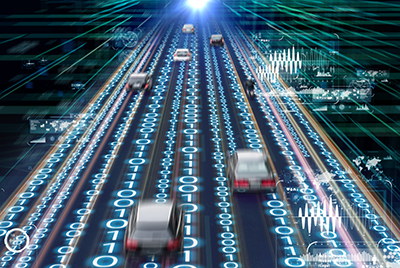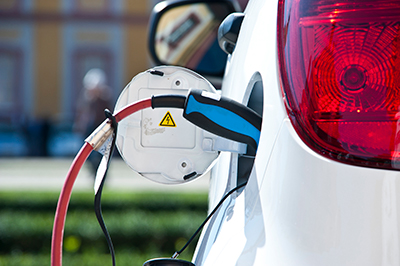Transportation Systems
Transportation Systems
Reliable, safe, fast, and affordable transportation is vital to U.S. economic development. In the face of rapid and major transformations to mobility — including carsharing, ridesharing and other mobility services, and increasing connectivity and automation — focused research and critical technological, engineering breakthroughs are necessary to deliver a transportation system that is robust, resilient, and responsive.
Our transportation research is part of the Energy Technology Area’s Transportation Initiative and focuses on a variety of hardware and systems science research and development pathways to discover solutions to reduce the energy intensity that supports the transportation of people and goods in our economy.
Mobility Decision Science

People play a key role in the dynamics of our current transportation infrastructure. Individual and family decisions about mode, time of departure, purchasing behaviors, vehicle type and housing location contribute to how individuals engage with the transportation system. We conduct survey research and discrete choice analysis that makes contributions in the field of mobility modeling, drawing upon behavioral economics and understanding that mobility decisions made by travelers in the short-, medium-, and long-term are interconnected. Through our WholeTraveler project, we strive to understand trends and patterns in transportation behaviors of multiple relevant populations, including both the demand and supply of emerging transportation services such as ridehailing and vehicle sharing platforms. We quantitatively analyze how travelers, consumers, firms and government institutions make travel decisions across different timescales, as well as the technological transitions that can impact energy demand. We use these insights to inform technological, and economic pathways to an energy secure transportation future.
Advanced Travel Demand & System Operations Modeling
As new mobility options and new vehicle technologies disrupt the transportation system, urban planners, providers of mobility services, and researchers alike require new simulation capabilities to design and analyze the impacts of demand-responsive transportation and vehicle automation. How will these new modes interact with incumbent modes, with traveler behaviors, with road capacities, or with charging and parking infrastructure? We have developed the BEAM agent-based travel demand model (Behavior, Energy, Autonomy, and Mobility) to address these questions. With BEAM, we seek to quantify the energy and mobility impacts of shared mobility, vehicle automation, and vehicle electrification by seeking the general equilibrium between coupled resource markets in the transportation system. We represent the operations of ridehailing and other new mobility services in detail, offering a platform for development of novel system management algorithms. We deploy the model within an ecosystem of other models and tools developed at LBNL, UC Berkeley, and across the Department of Energy, in order to conduct rich evaluations of potential transportation futures and their energy implications.
Land-Use Transportation Interactions
Substantial interactions and feedback mechanisms exist between urban form and transportation which are likely to shift as mobility options change. We are developing a tight coupling of the UrbanSim land use simulation model with the BEAM agent-based model of individuals’ travel decisions to explore the impacts of future mobility technologies and travel demand on urban form and regional mobility energy productivity.
Transportation Data Analytics

A new era has emerged where the world of transportation has the opportunity to enable decision-making based on large-scale data analytics. We are bringing this paradigm to the next generation by working on needed breakthroughs in machine learning, cloud computing and control and optimization. The multi-lab Big Data Solutions for Mobility (BDSM) project leverages our expertise and state-of-the-art computing facilities to incorporate and process the critical data streams required to model mobility and develop an understanding of how our transportation network is being accessed today. This helps us build new mobility-as-a-service models that simulate at regional scales that help predict future optimized mobility scenarios.
Connected & Automated Vehicles
Connected and automated vehicles (CAVs) operate without direct driver input, and also communicate with other vehicles and the roadway infrastructure, which can improve vehicle safety and efficiency. As CAVs become a significant share of all on-road vehicles, we will see impacts on traffic flow, transportation modes, and energy consumption. To understand the extent of these effects, our research focuses on the optimization of CAV technologies for passenger cars and trucks, testing the behavior of CAVs in real-world traffic, developing energy saving CAV strategies, and incorporating Eco-Driving strategies that optimize energy consumption and traffic patterns. This work will help to identify effective strategies and technologies to improve traffic mobility and energy savings.
Vehicles & The Grid

To complement technology development efforts, system modeling and analysis are necessary to accelerate pathways to large-scale electrified transport. In this research area we assess the long-run economic, environmental and energy benefits, and costs of substantially electrifying U.S. road transportation. We develop agent-based electric vehicle adoption and power system dispatch models to simulate and optimize EV charging demand coordinated with a grid composed primarily of intermittent sources of generation. Our analysis spans the full range of electrified mobility systems of the future, from one composed primarily of privately owned EVs to one dominated by shared, autonomous, electrified fleets serving mobility on-demand. Our toolsets allow for couplings between detailed travel demand and power market simulation models, but also allow for policy analysis at a national scale through lightweight planning and operation models that explore the consequences of major trends in the transportation and electricity sectors. With these tools we estimate the benefits and costs that result from large-scale deployment of electric vehicles when jointly planned and operated in coordination with the electric grid.
